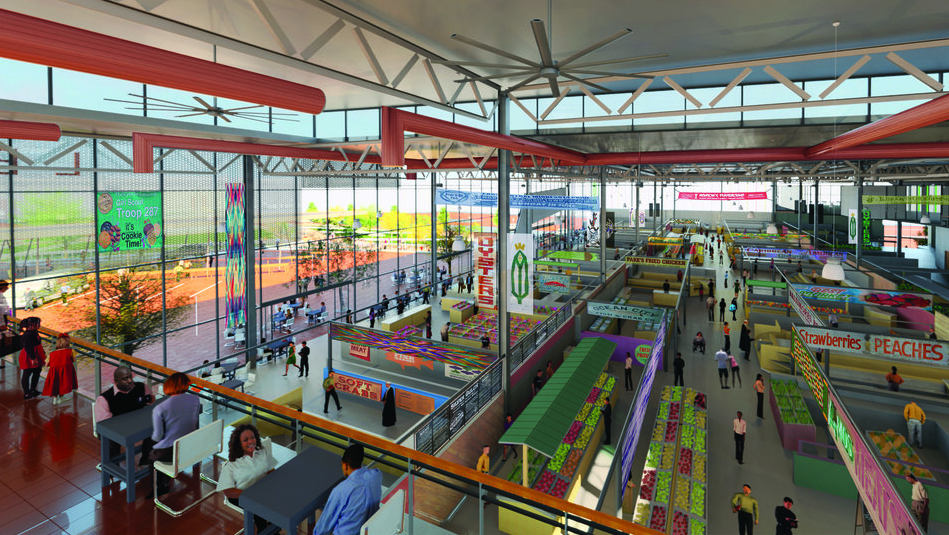
Mayor Stephanie Rawlings-Blake might be on her way out of office, but there is one major project she made it a priority to address in the final days of her term.
Last week, the mayor, along with officials from the Baltimore Public Markets Corporation, announced a new proposal that would demolish the current Lexington Market building and create a brand new, 97,000-square-foot facility in a parking lot just south of the property.
After all of the merchants make the transition to the new space, the present-day market will be razed and transformed into a public park, which will serve as a venue for outdoor farmers’ markets and other community events.
“Baltimore is a city of neighborhoods,” says Lexington Market manager Stacey L. Pack. “Sometimes it’s hard for folks to get out of their neighborhoods, but Lexington Market truly is the city’s public market. Whether you’re eating oysters at the raw bar or picking up produce, it’s this wonderful crossroads for people from all walks of life, and we’re excited about keeping that tradition going.”
A few years back, stakeholders came up with a master plan to revamp Lexington Market in its current building, which was built in 1952 after the original structure, erected in 1803, burned down in a six-alarm fire three years earlier.
Pack says that the course of action shifted from a redesign to a complete redevelopment while management was conducting one-on-one meetings with each of the merchants to discuss the master plan. It was in one of these meetings that Faidley’s Seafood owner Bill Devine suggested building a new space entirely, rather than displacing tenants during construction of the current market.
“He was the one who originally said, ‘Doesn’t it make more sense to move into the lot right next to us rather than move everyone around?’” Pack says. “And the architects agreed.”
Fourth-generation Faidley’s owner Dayme Hahn, Bill and Nancy Devine’s daughter, explains that the thought of disrupting business hit particularly close to home for her family’s stall, which has been around since 1886.
“It took a couple of years to rebuild after the fire in 1949,” Hahn says. “So during that time my grandmother sold our seafood from a cart in the garage across the street, while my grandfather was forced to find another job.”
Hahn says that, though the situation was more severe in the ’50s, she’s happy that her family’s business won’t be impeded again.
“The thought of our regular business being disrupted was really weighing heavily on my dad,” Hahn says. “Realistically, you can’t just close the doors and expect people to come back.”
Though the aesthetic will be completely different, Hahn is confident that history of the market will be preserved in the new space.
“The current building was a quick replacement in my grandmother’s era after the fire,” she says. “So it’s really the site that has the historical significance, not the building itself. We’ve hesitated to modernize anything because you can’t put new on top of old. The infrastructure needs to be taken care of first.”
In addition to it being more convenient for tenants, Pack says that, because the new building will be smaller (roughly 70 percent of the current market space), it will also be more cost and energy efficient. The $40-million project, slated to debut in 2018, will feature floor-to-ceiling glass walls, new storage facilities, upgraded refrigeration systems, custom-designed tenant stalls, clear sightlines, better ventilation, level floors, and a community test kitchen.
“We’re very excited—it’s going to be much better-looking,” says Berger’s Bakery owner Minus Houvardas, who moved to Baltimore from Greece in 1974 and has worked in the market ever since. “We hope new customers come to see it and come back regularly.”
Houvardas notes that, throughout his 40 years in business, he has enjoyed seeing regulars bring their children and grandchildren, and hopes that the new upgrades will allow this tradition to continue.
“I don’t call my customers ‘customers,’” he says. “I call them my friends. They come to the market and eat here like this is their home. It’s not like going to the grocery store where nobody knows you.”
Ron Tuli, owner of Lexington Market’s Memsahib Restaurant, says that, while it’s sad to think about the home of his 15-year-old business being destroyed, enhancements are much-needed.
“The market is a jewel for the city, and it needs to be taken care of,” he says. “Hopefully we can create a safer, cleaner environment and eliminate some of the stereotypes that have inhibited people from coming to visit in the past. Once we rebuild, it’s a clean slate.”
